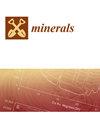Mineralogy of Gold, Tellurides and Sulfides from Lianzigou Gold Deposits in the Xiaoqinling Region, Central China: Implications for Ore-Forming Conditions and Processes
IF 2.2
4区 地球科学
Q2 GEOCHEMISTRY & GEOPHYSICS
引用次数: 0
Abstract
The Lianzigou deposit, which has an Au–Te paragenetic association, is hosted in plagioclase gneiss of the Qincanggou Formation in the Taihua Group in the Xiaoqinling region, central China. This quartz vein-type Au deposit comprises native Au and a variety of tellurides. The latter include calaverite (AuTe2), krennerite (Au3AgTe8), petzite (Au3AgTe2), hessite (Ag2Te), melonite (NiTe2), and altaite (PbTe). Four stages have been recognized in this deposit: stage I consists of K-feldspar and quartz; stage II is of milky quartz veins accompanied by coarse-grained disseminated and lumps of pyrite with weak Au mineralization; stage III is composed mainly of Au, tellurides, and sulfides; and stage IV is characterized by abundant carbonate and quartz. Based on mineral assemblage and thermodynamic data, we estimated the physicochemical conditions of the main metallogenic stages. Based on thermodynamic modelling, the physicochemical conditions of Au–Ag–Te mineral associations were estimated. The Au–Ag–Te minerals from stage III formed mainly under conditions of logƒO2 = −43.15 to −33.31, logƒH2S = ~−9.29, pH < 7, logfTe2 = −10.6 to −9.8 and logαAu+/αAg+ = −7.2 to −6.5. In contrast, the physicochemical conditions of stage II were higher, specifically pH (8.3–8.5) and logƒO2 (−34.90−31.96). In the ore-forming fluids of the Lianzigou deposit, the dominant Au species was Au(HS)2− while the dominant Te species were HTe−(aq) and Te22−(aq). Moreover, the Au–Ag–Te metal associations in the Lianzigou Au deposit were derived from mantle materials related to lithospheric thinning of the eastern North China craton in the Early Cretaceous under an extensional tectonic system.中国中部小秦岭地区莲子沟金矿床的金、碲化物和硫化物矿物学:对成矿条件和过程的影响
莲子沟金矿位于中国中部小秦岭地区太华组秦仓沟地层的斜长岩片麻岩中,具有金-碲副成因关系。该石英脉型金矿床由原生金和多种碲化物组成。后者包括钙钛矿(AuTe2)、克伦尼特矿(Au3AgTe8)、辉绿岩(Au3AgTe2)、黑云母(Ag2Te)、瓜铁矿(NiTe2)和阿尔泰岩(PbTe)。该矿床分为四个阶段:第一阶段由钾长石和石英组成;第二阶段为乳白色石英脉,伴有粗粒散粒状和块状黄铁矿,金矿化程度较弱;第三阶段主要由金、碲化物和硫化物组成;第四阶段的特征是富含碳酸盐和石英。根据矿物组合和热力学数据,我们估算了主要成矿阶段的物理化学条件。根据热力学模型,估算了金银碲矿物组合的物理化学条件。第三阶段的金银铜矿物主要是在 logƒO2 = -43.15 至 -33.31、logƒH2S = ~-9.29、pH < 7、logfTe2 = -10.6 至 -9.8、logαAu+/αAg+ = -7.2 至 -6.5 的条件下形成的。相比之下,第二阶段的物理化学条件更高,特别是 pH 值(8.3-8.5)和 logƒO2(-34.90-31.96)。在莲子沟矿床的成矿流体中,主要的 Au 物种是 Au(HS)2-,而主要的 Te 物种是 HTe-(aq)和 Te22-(aq)。此外,莲子沟金矿床中的金银碲金属伴生体来源于地幔物质,与早白垩世扩展构造体系下华北东部克拉通岩石圈变薄有关。
本文章由计算机程序翻译,如有差异,请以英文原文为准。
求助全文
约1分钟内获得全文
求助全文
来源期刊

Minerals
MINERALOGY-MINING & MINERAL PROCESSING
CiteScore
4.10
自引率
20.00%
发文量
1351
审稿时长
19.04 days
期刊介绍:
Minerals (ISSN 2075-163X) is an international open access journal that covers the broad field of mineralogy, economic mineral resources, mineral exploration, innovative mining techniques and advances in mineral processing. It publishes reviews, regular research papers and short notes. Our aim is to encourage scientists to publish their experimental and theoretical results in as much detail as possible. There is no restriction on the length of the papers. The full experimental details must be provided so that the results can be reproduced.
 求助内容:
求助内容: 应助结果提醒方式:
应助结果提醒方式:


